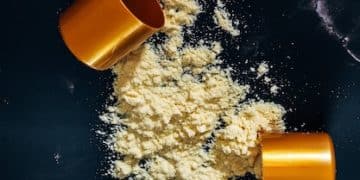Cardio Confusion: Best Cardio for Fat Loss and Muscle Preservation

Navigating the complexities of cardiovascular exercise for optimal fat loss while preserving muscle can be perplexing, as different cardio modalities offer unique metabolic advantages and impact body composition distinctly, requiring a strategic approach to achieve balanced fitness goals.
In the pursuit of a leaner physique, few topics generate as much debate and confusion as cardio. Specifically, the challenge lies in resolving the perennial question: Cardio Confusion: Which Type is Best for Fat Loss and Muscle Preservation? For anyone dedicated to sculpting their body, striking the delicate balance between shedding fat and safeguarding hard-earned muscle is paramount. This article cuts through the noise, offering evidence-based insights to guide your cardio choices.
understanding the fat loss equation
Achieving sustainable fat loss transcends mere calorie counting; it involves a sophisticated interplay of metabolic processes, hormonal responses, and exercise modalities. For many, integrating cardiovascular training is a fundamental component of this equation, yet the nuances of how different cardio types influence the body’s energy systems and body composition are frequently misunderstood.
When we talk about fat loss, we’re essentially discussing creating a caloric deficit. While diet plays the most significant role, cardio acts as a powerful tool to augment this deficit and enhance metabolic flexibility. However, not all cardio is created equal in this regard. The intensity, duration, and frequency of your cardiovascular exercise can significantly alter how your body burns fuel and responds to training stimuli.
metabolic pathways and fuel sources
Our bodies utilize different energy systems depending on the intensity and duration of an activity. Understanding these pathways is crucial for optimizing cardio for fat loss. At lower intensities, the body primarily relies on aerobic metabolism, using oxygen to break down fats for fuel. As intensity increases, the reliance shifts towards carbohydrates (glycogen) through anaerobic pathways. The goal for fat loss is often to maximize fat oxidation without excessive glycogen depletion that could compromise strength training or muscle recovery.
- Low-intensity steady-state (LISS) cardio: Predominantly taps into fat stores for fuel, ideal for longer durations.
- High-intensity interval training (HIIT): Heavily relies on glycogen but creates a significant “afterburn” effect (EPOC), burning more calories post-exercise.
- Moderate-intensity steady-state (MISS) cardio: A blend, utilizing both fat and carbohydrate stores.
It’s important to recognize that while LISS directly burns a higher percentage of fat during the activity, HIIT can burn more total calories in a shorter period and elevate post-exercise metabolism, leading to greater overall fat oxidation over 24 hours. The optimal approach often involves strategically incorporating both to leverage their distinct benefits.
Hormonal responses also play a critical role. High-intensity exercise can transiently elevate growth hormone and catecholamines, which are lipolytic (fat-releasing) hormones. Conversely, excessive or poorly timed cardio can lead to elevated cortisol levels, potentially hindering fat loss and even promoting muscle breakdown. Therefore, the strategic application of cardio is key to manipulating these hormonal landscapes favorably.
The duration and frequency of your cardio sessions must also align with your overall training volume and recovery capacity. Overtraining, particularly with cardio, can compromise strength gains, impair recovery from resistance training, and increase the risk of injury. A balanced approach ensures that cardio complements, rather than detracts from, your primary goal of fat loss and muscle preservation.
low-intensity steady-state (LISS) cardio: the classic approach
Low-Intensity Steady-State (LISS) cardio has long been a staple in fat loss regimens. This type of exercise is characterized by its sustained, moderate pace, where the individual maintains a consistent heart rate, typically within 50-70% of their maximum heart rate, for an extended period, usually 30-60 minutes or longer. Common examples include brisk walking, light jogging, cycling, or using an elliptical machine.
The primary appeal of LISS cardio for fat loss lies in its profound reliance on fat as a fuel source during the exercise session itself. At lower intensities, the body’s aerobic system is highly efficient, utilizing oxygen to break down stored triglycerides into fatty acids for energy. This makes LISS an excellent choice for directly targeting fat oxidation without excessively depleting muscle glycogen stores, which are crucial for subsequent strength training sessions.
advantages of LISS for muscle preservation
One of the most significant benefits of LISS, especially for individuals focused on muscle preservation, is its minimal impact on recovery. Unlike high-intensity workouts that can induce significant muscle damage and systemic fatigue, LISS places less stress on the central nervous system and skeletal muscles. This means it can be performed more frequently and for longer durations without impeding strength gains or hindering recovery from resistance training.
- Reduced muscular fatigue: Allows for consistent strength training without overtaxing muscles.
- Lower risk of overtraining: Less systemic stress compared to high-intensity methods.
- Improved cardiovascular health: Strengthens the heart and lungs over time, enhancing overall fitness.
- Enhanced fat oxidation during exercise: Directly targets fat as the primary fuel source.
Moreover, LISS cardio is highly accessible and generally low-impact, making it suitable for a wide range of fitness levels and individuals recovering from injuries or those new to exercise. Its lower perceived exertion also makes it easier to sustain for longer periods, contributing to a greater total caloric expenditure over time without the risk of burnout.
However, it’s also important to acknowledge that while LISS burns a higher percentage of fat during the workout, the total caloric expenditure per unit of time is typically lower than higher-intensity methods. This means you need to spend more time performing LISS to burn the same number of calories as a shorter, more intense session. For those with limited time, or for individuals looking to maximize the “afterburn” effect, LISS might not be the most time-efficient option.
Incorporating LISS into a fat loss and muscle preservation strategy often involves performing it on separate days from strength training, or as an active recovery session. Its gentle nature makes it an ideal complement to a rigorous weightlifting program, providing cardiovascular benefits and fat oxidation without compromising muscle integrity or recovery.
high-intensity interval training (HIIT): the metabolic powerhouse
High-Intensity Interval Training (HIIT) has surged in popularity, becoming a cornerstone for many seeking rapid fat loss and improved cardiovascular fitness. Characterized by short, intense bursts of anaerobic exercise followed by brief recovery periods, HIIT pushes the body to its limits, activating different metabolic pathways compared to LISS. This form of cardio can involve a variety of exercises, from sprints and cycling to burpees and jump squats, all performed at near-maximal effort.
The primary mechanism through which HIIT promotes fat loss is not just the calories burned during the workout, but the significant “afterburn effect” or Excess Post-exercise Oxygen Consumption (EPOC). After a HIIT session, your body continues to burn calories at an elevated rate for hours, even up to 24 hours, as it works to recover, restore oxygen levels, and repair muscle tissue. This elevated metabolism contributes substantially to overall caloric expenditure.
benefits and considerations for muscle preservation
One of the most compelling arguments for HIIT in the context of muscle preservation is its ability to stimulate pathways often associated with muscle growth, rather than breakdown. The high intensity can trigger the release of growth hormone, which plays a role in fat metabolism and muscle building. Additionally, the short duration of HIIT sessions, typically 20-30 minutes including warm-up and cool-down, means less time spent in a catabolic state compared to very long steady-state workouts.
- Significant EPOC: Burns more calories post-exercise, enhancing total fat loss.
- Time-efficient: Shorter workouts yield substantial benefits.
- Preserves muscle mass: High intensity can be less catabolic than prolonged LISS.
- Improves anaerobic and aerobic capacity: Enhances overall athletic performance.
However, the intense nature of HIIT also comes with caveats. It places significant stress on the central nervous system and muscles, necessitating adequate recovery time. If performed too frequently or without proper recovery, HIIT can lead to overtraining, increased cortisol levels, and a higher risk of injury, all of which can hinder both fat loss and muscle preservation.

For individuals integrating HIIT into a weightlifting program, proper periodization and timing are crucial. It’s often recommended to perform HIIT on separate days from heavy leg training, or to structure the week to allow for sufficient recovery. Limiting HIIT sessions to 2-3 times per week is a common recommendation to prevent overtraining and ensure maximal recovery for strength gains.
While HIIT has been shown to be effective for fat loss, its direct impact on muscle preservation compared to LISS is more nuanced. The high intensity can create a demand that, coupled with adequate protein intake and resistance training, supports existing muscle mass. Nevertheless, it’s not a direct muscle builder on its own and should be seen as a complementary tool in a comprehensive fat loss and strength regimen.
moderate-intensity steady-state (MISS) cardio and circuit training
Stepping beyond the binary of LISS and HIIT, Moderate-Intensity Steady-State (MISS) cardio presents a middle-ground approach. Performed at an intensity higher than LISS but lower than HIIT (typically 70-80% of max heart rate), MISS sessions generally last between 20-45 minutes. This category often includes activities like sustained running, swimming, or cycling at a challenging but maintainable pace.
MISS cardio utilizes a blend of fat and carbohydrates for fuel. While it may not offer the direct fat-burning percentage of LISS nor the EPOC benefits of HIIT to the same extent, it provides a robust cardiovascular workout that can contribute significantly to a caloric deficit over time. It’s also less taxing on the body than HIIT, making it a viable option for more frequent inclusion in a training program without as high a risk of overtraining.
circuit training: combining strength and cardio
Circuit training offers a unique and highly effective method for simultaneously targeting fat loss and muscle preservation. This approach involves performing a series of resistance exercises with minimal rest between them, followed by a short break before starting the next circuit. While not strictly “cardio” in the traditional sense, the continuous movement and elevated heart rate throughout a circuit session provide significant cardiovascular benefits.
The beauty of circuit training lies in its dual benefit: it builds and maintains muscle mass through resistance exercise while elevating heart rate sufficiently to burn a substantial number of calories. This hybrid approach leverages the muscle-preserving effects of strength training with the caloric expenditure of cardio, making it incredibly efficient for body recomposition.
For fat loss, circuit training is highly effective due to its high caloric expenditure both during and after the workout (owing to the EPOC generated by the resistance component). For muscle preservation, it’s arguably superior to traditional cardio methods alone because it directly stresses and stimulates muscle fibers, signaling their retention or even growth, especially in a caloric deficit.
The adaptability of circuit training is another major advantage. Workouts can be tailored to individual fitness levels, available equipment, and specific muscle groups. You can incorporate bodyweight exercises, free weights, resistance bands, or machines, making it a versatile option for nearly anyone.
When implementing circuit training for fat loss and muscle preservation, focus on compound movements that engage multiple muscle groups (e.g., squats, deadlifts, push-ups, rows). Aim for 3-5 rounds of a circuit, with 8-15 repetitions per exercise, and keep rest periods between exercises short (15-30 seconds) to maintain an elevated heart rate. Rest between circuits can be 60-90 seconds.
Despite its benefits, circuit training requires a foundational level of strength and proper form for each exercise to prevent injury. It can also be quite taxing, so careful program design to allow for adequate recovery is essential, especially when combined with other forms of training.
the role of nutrition and recovery
While the type of cardio you choose plays a significant role in fat loss and muscle preservation, it’s crucial to understand that exercise alone is insufficient. Nutrition and recovery are equally, if not more, critical components that dictate the success of your body recomposition journey. Neglecting these pillars renders even the most meticulously planned cardio regimen less effective, potentially leading to plateaued progress or even muscle loss.
For fat loss, creating a sustainable caloric deficit is paramount. This means consuming fewer calories than your body expends. However, this deficit must be managed carefully. A drastic reduction in calories can lead to muscle catabolism, as the body seeks alternative fuel sources, including protein from muscle tissue. Therefore, the goal is a moderate deficit that encourages fat oxidation while sparing muscle.
protein intake and caloric deficit
Adequate protein intake is non-negotiable for muscle preservation during a caloric deficit. Protein provides the necessary amino acids for muscle repair and synthesis, counteracting the catabolic effects of training and energy restriction. Aim for 0.7 to 1 gram of protein per pound of body weight to support muscle mass. Distributing protein intake evenly throughout the day can also optimize muscle protein synthesis.
- Caloric deficit: Moderate and sustainable to promote fat loss without significant muscle breakdown.
- High protein intake: Essential for muscle repair and synthesis, typically 0.7-1g per lb of body weight.
- Carbohydrate timing: Strategically consume carbohydrates around workouts to fuel performance and recovery.
- Healthy fats: Support hormone production and overall well-being.
Carbohydrates, often demonized in fat loss discussions, are vital for fueling high-intensity exercise and replenishing muscle glycogen stores. Strategically consuming carbohydrates around your workouts can optimize performance, reduce the risk of muscle breakdown, and enhance recovery. Healthy fats are also important for hormone production and overall health, round out a balanced macronutrient profile.
Beyond macronutrients, micronutrient intake (vitamins and minerals) from a diverse diet is essential for supporting metabolic processes, immune function, and energy production. A nutrient-dense diet ensures your body has all the tools it needs to perform, recover, and operate efficiently.
Recovery is where the body adapts and strengthens. Sleep is arguably the most undervalued component of recovery. During deep sleep, the body releases growth hormone, which aids in cell repair and muscle growth, and regulates cortisol, the stress hormone that can promote fat storage and muscle breakdown if elevated persistently. Aim for 7-9 hours of quality sleep per night.
Active recovery methods, such as light walks, stretching, or foam rolling, can also aid in reducing muscle soreness and improving blood flow, facilitating quicker recovery. Stress management techniques, including mindfulness or meditation, also play a role in optimizing the physiological environment for fat loss and muscle preservation by keeping cortisol levels in check.
In essence, exercise creates the stimulus for change, but nutrition provides the building blocks for that change, and recovery allows the body to implement it. Neglecting nutrition and recovery means you are leaving significant progress on the table, regardless of how perfectly you execute your cardio and strength training.
integrating cardio into your training split
Successfully integrating cardio into your training split for optimal fat loss and muscle preservation requires careful planning and a personalized approach. The goal is to maximize the benefits of both cardio and strength training without causing interference effects that could hinder progress in either domain. This involves considering the type of cardio, its intensity, duration, and crucially, its timing relative to your resistance training sessions.
For most individuals aiming for body recomposition, the primary focus should remain on strength training to build and maintain muscle mass. Cardio then serves as a powerful adjunctive tool for accelerating fat loss and enhancing cardiovascular health. The key is to avoid excessive fatigue that could compromise your performance in the weight room.
strategic timing for different cardio types
The timing of your cardio sessions can significantly impact their effectiveness and your recovery. The general recommendation is to separate cardio and strength training sessions by at least 6 hours if performed on the same day. This allows for sufficient recovery and glycogen replenishment between different types of strenuous activity.
- LISS cardio: Ideal on rest days or as a separate session from strength training (e.g., morning cardio, evening weights). Can also be performed post-weight training if short (15-20 min) and low intensity, but watch for excessive fatigue.
- HIIT cardio: Best performed on separate days from heavy strength training, particularly leg days, to avoid central nervous system fatigue and allow for recovery. Limit to 2-3 times per week.
- MISS cardio: Versatile enough to be performed on separate days or at a different time on the same day as strength training, depending on individual recovery capacity.
If scheduling dictates same-day sessions, performing cardio after strength training is generally preferred. This ensures that your energy levels are maximized for lifting weights, which is crucial for muscle stimulation and strength gains. Performing cardio beforehand can pre-fatigue muscles and deplete glycogen stores, potentially impacting your lifting performance.
Additionally, consider the overall volume and intensity of your combined training. If you are training with high frequency and intensity in the gym, adding excessive cardio could push you into an overtrained state. Symptoms of overtraining include persistent fatigue, decreased performance, increased irritability, and impaired sleep. Listening to your body and adjusting your schedule based on energy levels and recovery is paramount.

For those new to integrating cardio with strength training, starting slowly and gradually increasing intensity and duration is advisable. Begin with 2-3 cardio sessions per week, and adjust as your body adapts. Periodization of your cardio can also be beneficial, meaning you might cycle through periods of higher and lower cardio volume or intensity to align with specific training cycles (e.g., lower cardio during a strength phase, higher during a cutting phase).
Ultimately, there is no one-size-fits-all answer. Your ideal cardio integration will depend on your current fitness level, recovery capacity, specific fat loss goals, and how your body responds to different stimuli. Experimentation, coupled with a keen awareness of your body’s signals, will help you find the most effective and sustainable training split.
common mistakes and how to avoid them
Navigating the path of fat loss and muscle preservation through cardio is often riddled with common pitfalls. Many individuals, armed with good intentions but sometimes incomplete information, fall into traps that can hinder their progress or even lead to unwanted muscle loss. Recognizing these mistakes is the first step towards a more effective and sustainable approach.
One of the most prevalent errors is excessive cardio. While cardio is a powerful tool for creating a caloric deficit, “more is not always better.” Overdoing cardio, especially high-intensity or prolonged steady-state sessions, can lead to increased cortisol levels. Chronically elevated cortisol can promote muscle breakdown, increase fat storage (particularly visceral fat), and impair recovery. This counteracts the very goals of fat loss and muscle preservation.
under-eating and neglecting recovery
Another critical mistake is attempting to out-train a poor diet or severely under-eating in conjunction with intense training. While a caloric deficit is necessary for fat loss, an overly aggressive deficit, especially when coupled with high training volume, can lead to muscle catabolism. The body, deprived of sufficient energy and nutrients, will start breaking down muscle tissue for fuel. This compromises your metabolism in the long run and makes it harder to maintain a lean physique.
- Doing too much cardio: Leads to overtraining, increased cortisol, and potential muscle loss.
- Neglecting strength training: Focus solely on cardio, missing the muscle-preserving benefits of resistance work.
- Inadequate protein intake: Without enough protein, muscles cannot repair or maintain themselves in a deficit.
- Poor sleep: Impairs hormone regulation, recovery, and overall performance.
Similarly, neglecting sleep and active recovery strategies is a significant oversight. Recovery is when your body repairs and adapts. Insufficient sleep impacts hormonal balance (e.g., ghrelin and leptin, cortisol, growth hormone) crucial for fat loss and muscle preservation. A lack of rest also affects performance in subsequent workouts, leading to suboptimal training sessions and increased injury risk.
Focusing solely on cardio while neglecting strength training is another common pitfall. While cardio burns calories, strength training is the primary driver of muscle maintenance and growth, which is metabolically active tissue. Losing muscle mass decreases your basal metabolic rate, making long-term fat management more challenging. A balanced program always integrates both strength and cardio.
Lastly, falling into a routine without assessing progress or making adjustments can lead to plateaus. The body adapts to stress, so consistently doing the same type, intensity, or duration of cardio will eventually yield diminishing returns. Incorporating progressive overload for strength training and varying cardio modalities, intensities, and durations keeps the body guessing and drives continued adaptation. Regularly assessing your body’s response, adjusting nutrition and training, and prioritizing recovery are essential for sustained progress.
optimizing your cardio strategy for results
Developing an optimal cardio strategy for fat loss and muscle preservation is not a one-size-fits-all endeavor; rather, it’s a dynamic process that integrates scientific principles with individual needs and responses. The most effective approach often involves a combination of modalities, meticulously timed and adjusted to complement your strength training and nutritional intake.
The overarching principle is to use cardio as a strategic tool to enhance caloric expenditure and metabolic flexibility, without compromising muscle mass or recovery from resistance training. This means avoiding excessive volume and choosing the right intensity at the right time.
the power of periodization and personalization
A highly effective strategy is to periodize your cardio, just as you would with strength training. This means cycling through different types, intensities, and durations of cardio over specific periods to achieve different goals and prevent plateaus. For example, you might focus on higher volume LISS during a prolonged caloric deficit phase to maximize fat oxidation, and then transition to more intermittent HIIT sessions during consolidation phases or when time is limited.
Personalization is key. Your optimal cardio strategy will depend on several factors: your current fitness level, your specific body composition goals, your recovery capacity, the intensity and volume of your strength training, and even your personal preferences. What works for one individual may not be ideal for another.Experiment with different cardio types and timing to see how your body responds in terms of energy levels, recovery, and body composition changes.
Listen intently to your body. Signs of overtraining—such as persistent fatigue, decreased performance, poor sleep, or increased irritability—are clear signals to reduce cardio volume or intensity, and prioritize recovery. Under-recovery undermines all other efforts. Conversely, if you feel consistently fresh and are progressing with both your cardio and strength, you’ve likely found a sustainable balance.
Finally, remember that cardio is a complement to, not a replacement for, foundational habits. A well-structured strength training program, a nutrient-dense diet with appropriate caloric intake, and adequate sleep remain the bedrock of successful fat loss and muscle preservation. Cardio is the accelerator, helping you reach your destination faster and more efficiently, but only if the core foundation is solid.
By strategically integrating various cardio modalities, prioritizing recovery, and aligning your efforts with your nutritional strategy, you can confidently navigate the “cardio confusion” and sculpt the lean, muscular physique you desire. The journey requires patience, consistency, and a willingness to adapt, but the results are undoubtedly worth the intelligent effort.
| Key Point | Brief Description |
|---|---|
| 🏃♂️ LISS Cardio | Low-intensity, extended duration, primarily burns fat during exercise, easy on recovery. |
| ⚡ HIIT Cardio | High-intensity intervals, creates significant “afterburn” (EPOC), time-efficient. |
| 🏋️♂️ Circuit Training | Blends resistance training and cardio, excellent for muscle preservation and calorie burn. |
| 🥗 Nutrition & Recovery | Crucial for fat loss and muscle retention; includes protein intake, caloric deficit, and sleep. |
frequently asked questions
▼
While diet creates the primary caloric deficit for fat loss, cardio significantly enhances this process and offers numerous health benefits. It helps burn additional calories, improves cardiovascular health, and can enhance metabolic flexibility. However, it’s not strictly “essential” if a sufficient deficit is maintained through diet alone, but it greatly optimizes fat loss efforts.
▼
Yes, excessive or inappropriately planned cardio, especially when coupled with a severe caloric deficit and insufficient protein intake, can lead to muscle catabolism. Prolonged cardio can elevate cortisol, promoting muscle breakdown. Balanced programming and adequate nutrition are crucial to minimize this risk, prioritizing strength training for muscle preservation.
▼
For individuals prioritizing muscle gain and strength, performing cardio after resistance training is generally recommended. This ensures your energy levels and muscle glycogen stores are maximized for your weightlifting session, which is crucial for stimulating muscle growth and maintaining strength. If cardio must be done first, keep it short and low intensity.
▼
The optimal frequency depends on the type of cardio and your overall training volume. For LISS, 3-5 sessions per week are common. For HIIT, 2-3 sessions per week are usually sufficient due to its high intensity and recovery demands. Listening to your body and ensuring adequate recovery is more important than hitting a specific number of sessions.
▼
Walking, particularly brisk walking (a form of LISS), can be an effective component of a fat loss strategy, especially for beginners or those with limited time for other exercise forms. It contributes to caloric expenditure and offers many health benefits with low impact and minimal recovery needs. For optimal results, combine it with strength training and a proper diet.
conclusion
Navigating the complex landscape of cardio for fat loss and muscle preservation truly boils down to understanding that no single modality reigns supreme. The most effective strategy is a dynamic, personalized approach that intelligently integrates various types of cardio—LISS for sustained fat oxidation and recovery, HIIT for metabolic impact and efficiency, and circuit training for a powerful strength-cardio hybrid. Crucially, these cardio choices must be underpinned by a solid foundation of consistent strength training, a meticulously managed nutritional intake with adequate protein, and disciplined recovery, especially sufficient sleep. By prioritizing these elements and continually assessing your body’s response, you can move beyond “cardio confusion” and effectively sculpt a lean, muscular, and resilient physique.





